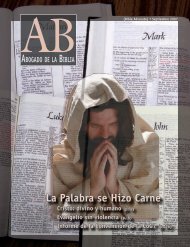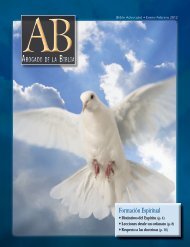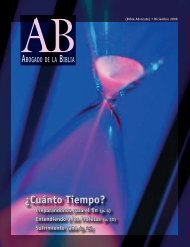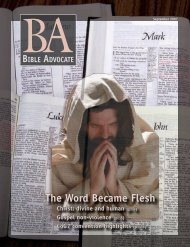English PDF - The Bible Advocate Online
English PDF - The Bible Advocate Online
English PDF - The Bible Advocate Online
Create successful ePaper yourself
Turn your PDF publications into a flip-book with our unique Google optimized e-Paper software.
Holy Spirit is not a third person of<br />
the Deity, in the same sense that the<br />
Father and Son are “persons.”<br />
If the article attributes a greater<br />
role to the work of the Holy Spirit<br />
than we have commonly recognized<br />
or emphasized, the author’s points in<br />
this regard are taken nearly verbatim<br />
from the biblical text — namely, the<br />
book of Acts. For the sake of Christ<br />
and the gospel, let us be willing to<br />
learn and grow in the teaching and<br />
ministry of the Holy Spirit.<br />
Idol talk<br />
Your response to T. A. — “<strong>The</strong><br />
second commandment prohibits, not<br />
the making of, but the worship of<br />
any physical symbol of deity” [“Mail<br />
Bag,” December, p. 24] — doesn’t<br />
make sense to me. Exodus 20:4, 5<br />
says, “You shall not make . . . you<br />
shall not bow down. . . .” Doesn’t<br />
this prohibit the making of an idol?<br />
Please shed some light on my confusion.<br />
S. C.<br />
Riverbank, CA<br />
Editor’s reply: <strong>The</strong> commandment<br />
(Exodus 20) states that we must not<br />
make any graven image of anything<br />
— any person, animal, mountain,<br />
tree, or flower (v. 4). If we stop<br />
there, no sculpture, portrait, image,<br />
or photograph of any object in the<br />
natural universe is permitted. Our<br />
children and grandchildren could<br />
have no dolls, stuffed animals, school<br />
photos, or most other toys. Some<br />
have taken it to that extreme.<br />
On the other hand, most <strong>Bible</strong><br />
students see that the first lines of<br />
verse 5 actually control and explain<br />
the meaning of verse 4: We may not<br />
make any of these items for the purpose<br />
of worship — i.e., as an idol.<br />
As long as we do not bow and serve<br />
them, then, they are not idols, and it<br />
is not wrong to make them.<br />
I wrote, “<strong>The</strong> second commandment<br />
prohibits, not the making of,<br />
but the worship of any physical<br />
symbol. . . .” Thinking only of the<br />
natural creation, this makes sense.<br />
Extending the sentence by adding<br />
“of deity,” as I did, complicates it,<br />
I admit. It suggests no limits on<br />
physical images of God and Christ, as<br />
long as we don’t bow down to them.<br />
Given our tendency to honor and<br />
adore symbols (parts of creation)<br />
rather than reality (the Creator), let’s<br />
not stretch the commandment too far<br />
by producing images, or symbols, of<br />
deity — especially of our Father God.<br />
<strong>The</strong>y too easily become idols.<br />
On the other hand, God, to make<br />
Himself known, came in the image<br />
and likeness of man: Christ. <strong>The</strong> worship<br />
Jesus received was not idolatry<br />
but reverence belonging to God<br />
alone. Is, then, the divine command<br />
violated by an artist’s conception<br />
of what the historical Jesus might<br />
have looked like? Or by a young man<br />
taking the role of Christ in a movie<br />
or play? Or by a children’s book using<br />
pictorial images of the Lord to illustrate<br />
familiar gospel stories?<br />
I think not. Such symbolic representations<br />
of the divine-human<br />
Son may have more of the effect of<br />
making God real than of stimulating<br />
idolatry. Yes, idols are prohibited by<br />
the second command, but representations<br />
of our Lord Jesus Christ for<br />
godly purposes aren’t necessarily<br />
idols.<br />
Reader responses to this fascinating<br />
topic are welcome and will be<br />
considered for publication in “Mail<br />
Bag.”<br />
<strong>The</strong> Scourge of<br />
Slavery<br />
continued from page 10<br />
How might the church’s younger<br />
generations prepare themselves<br />
for the long fight against<br />
slavery?<br />
Five-year-olds can understand<br />
slavery is wrong. Help them<br />
know that slavery isn’t just history.<br />
It’s now.<br />
Staying clear of vice — pornography<br />
and prostitution — is the<br />
single biggest way for everybody,<br />
young and old, to fight slavery<br />
and a host of other evils. Ridding<br />
ourselves of addictions of<br />
all sorts breaks the back of evil.<br />
It’s well established that cocaine<br />
and other illicit drugs are funding<br />
terrorism, civil wars, gang<br />
wars, mafias, and other horrors<br />
that lead to even more poverty,<br />
crime, hunger, illiteracy, domestic<br />
abuse, street children, disease,<br />
broken families, homelessness,<br />
joblessness, indebtedness, and<br />
other manifestations of hopelessness.<br />
If there were no demand for<br />
slaves, there would be no traffickers<br />
supplying these markets.<br />
Always pay your workers fair<br />
wages. We must ask ourselves<br />
what the human cost is for<br />
such cheaply produced goods.<br />
How can strings of handmade<br />
Christmas tree twinkle lights be<br />
sold for 99 cents? If it sounds<br />
too good to be true, there may<br />
be unpaid, forced labor behind<br />
it. We will all stand before the<br />
judgment seat of Christ to give<br />
account for our actions.<br />
January-February 2008 • 25
















